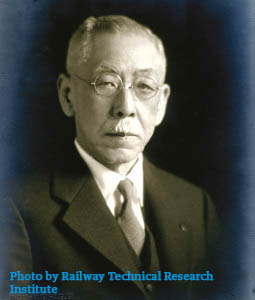Home > Highlighting JAPAN > Highlighting Japan October 2018 > From Meiji to the Present: Looking Back on 150 Years of Progress
Highlighting JAPAN


Japan’s Railway Legacy
Japan’s railways have made massive technological advances since the first line opened during the early Meiji Period. The superb rail network that now extends across the country—with shinkansen (bullet trains) running as frequently as commuter trains—offers a treasure trove of technology and know-how that is also being exported overseas.
Rail technology first reached Japanese shores in 1853, when Japanese people were astounded by the technical sophistication of a model of a Russian steam locomotive brought on a ship that landed in Nagasaki. Japan’s first train line opened nearly two decades later in 1872—twenty-nine kilometers of rail connecting Shimbashi in Tokyo with Yokohama. The railway became a symbol of Japan’s efforts to Westernize, and was even depicted in ukiyo-e woodblock prints.
The Tokaido Main Line, completed in 1889, stretched all the way from Shimbashi to Kobe. Traveling from Tokyo to Kyoto by train shortened the journey from around twelve days—stopping at inn towns along the way—to a single day. The advent of the shinkansen in 1964 cut that time radically, and is now under two and a half hours—spawning technology, techniques and know-how that Japan exports overseas.
Naofumi Nakamura, professor at The University of Tokyo’s Institute of Social Science, explains that international factors greatly influenced the railway’s quick spread during the Meiji Period. Japan’s drive to construct a railway began in earnest in 1869, the same year that saw a revolution in the world’s transportation systems, including the Suez Canal and the opening of the transcontinental railway in the U.S.
Japan also took the plunge into railway construction because transatlantic communication cables were being laid, and the country feared being left behind by accelerating markets and the globalization of information the transport and information revolutions had enabled. When competition intensified in the global market, railway materials became cheaper and more available, which boosted Japan’s ability to purchase them. Many leading overseas manufacturers from countries like England, the U.S. and Germany entered the Japanese market, supplying excellent machinery and locomotives. Japanese engineers learned sophisticated techniques from these exemplars, leading to the development of Japanese-built locomotives toward the end of the Meiji Period.
One person who played an instrumental part in advancing rail technologies domestically was railway engineer Yasujiro Shima. Shima learned about railways in Germany, and in 1906 took control of the Japanese government’s railway construction department after it was nationalized. He later helped devise a compact locomotive adapted to Japan’s narrow-gauge tracks. The outbreak of World War I decimated global markets, consequently creating favorable conditions for Japanese railway development to flourish without the threat of imports.
The Tokaido Shinkansen began service in 1964, the pivotal year of the Tokyo Olympic and Paralympic Games, racing between Tokyo and Shin-Osaka in just four hours. Narrow-gauge tracks had hindered transportation capacity during this period of burgeoning national power, but Shinji Sogo—who became president of the national railway after the war—was able to lay wider, standard-gauge tracks for the shinkansen, enabling rapid, high-capacity transport.
A strong rail network spread through the country, and today the shinkansen runs at three-minute intervals and travels at 300 kilometers per hour. Nakamura asserts that the singularly safe and punctual operation of Japan’s railways owes its development to high population density and the high frequency of travel. In this mountainous nation the people congregate on flat land, and they ride the rails at an exceptionally high rate, even on an international scale. In the process of adding carriages and increasing the number of train services, Japanese railways became increasingly precise.
“The shinkansen network—Japan’s artery—is now reaching its limit, and we need to add routes,” Nakamura says. One such route is the Linear Chuo Shinkansen Line, which is still under construction. It is a track for maglev trains capable of traveling at speeds of 500 kilometers per hour, so it seems that Japanese railways will continue to stun the world with its technological advances.
© 2009 Cabinet Office, Government of Japan








